Eliza Knight's Blog, page 22
July 20, 2015
Steampunk Lessons from a Family History on Sawmill Operation ~ Part One By Laurel Wanrow
Welcome guest author Laurel Wanrow to History Undressed! Laurel has written a two part series about Sawmill Stories. Below you will find part one and she will be back again next week to share part two with us! Thank you Laurel for sharing with us!!
Steampunk Lessons from a Family History on Sawmill Operation ~ Part OneBy Laurel Wanrow

While writing The Unraveling, I was asked why I chose to locate my steampunk story in the countryside instead of London or another city, the gritty setting of most steampunks. I thought on this, and finally came to the conclusion it’s because I’d never been to London.
Now you have to understand, I’ve never lived on a farm either. But my dad did, and I’d been to plenty of farms. It’s a case of write what you know…almost. Machinery and steam engines were new territory for me, but here I had family help again. My grandfather—my dad’s father—owned and ran steam engines. Through stories my dad and his sister told I could more easily imagine life on a farm working with those big engines than any adventure in London’s back alleys.
Let me stop here and give fair notice that this article is an oral history, not a research document. This two part series of sawmill stories is a recollection of the times and how I used family tales to enhance my novel.
My grandfather, Herbert F. Wanrow, was a first generation American born in 1889 to a farming family in eastern Nebraska. But Herb didn’t seem to take to that life. Typical of most young men, he liked fancy cars…but needed an income to get them. By the time Herb reached his twenties in the 1910s, he was selling farm machinery. Companies such as Gleaner, Oliver, Avery, Case and Meikle shipped the parts in crates by rail to their nearest town, Humboldt, and Herb hauled them home with a horse and wagon and put them together.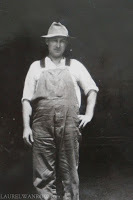
Selling farm machinery was seasonal work, so pretty quickly Herb put his money into purchasing a sawmill to keep work going into the fall and winter.
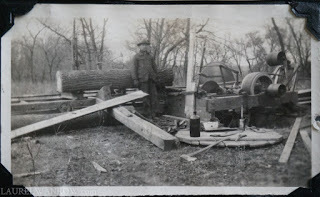
Pouring over our photos, I got a sense of scale for an operation that these days most of us only see the results of in Home Depot. My grandfather’s sawmill consisted of the large upright blade and its mechanical parts, all of which were mounted in a substantial wheeled platform. Under the platform is a pit, dug to accommodate the sawdust. To move a sizable log—such as the one Herb is leaning against—past the blade with the precision to produce lumber required a wheeled carriage set on rails. This log (once cut, the tree trunk was always referred to as a log) has passed through the blade three times already to ‘square it up’, or remove the bark. After the final bark slab is removed, it’ll be called a cant.
For all that, the sawmill is only half the equipment needed; like many machines of the day, it wasn’t self-powered, but operated with a secondary source. By 1923, self-propelling machinery was being patented, but that doesn’t mean everyone could or did use it. During this time, in this part of Nebraska, horses or mules still powered the farm implements. But a sawmill required more power, so Herb also bought a steam engine. Its power is transmitted to the sawmill with a belt that runs around the wheel-like pulley to the far right.
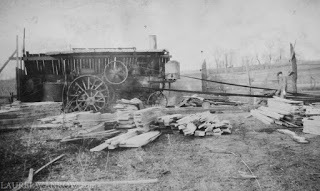
Herb set up his steam engine with a windbreak of slabs some distance from the sawmill and ran the long belt between the two. Feeding wood—usually the endless supply of slabs—into the firebox at the back was the work of one full-time helper, a fireman. Another helper filled the water tanks on the back and front of the engine from a water tank on a wheeled carriage…and kept that water tank refilled from the closest source.
For one entrepreneur, Herb (in the felt hat) ran quite an operation. Beyond his fireman, the hands helping were usually the customer he was cutting wood for, and his boys or hired hands. They rolled the log onto the carriage, and then turned it with cant hooks. Using the upright ‘dogs’ to hold the log in place on the rolling carriage, Herb moved log after log through the blade to produce cants. From them, he cut the rough lumber to fill his customers’ orders.
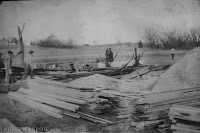 Only Herb did the sawing, riding in a seat along the cant. It was an art to size up and turn the cant to get the most efficient board feet out of it. Depending on what board dimensions the customer desired—thickness and length—Herb either advanced the cant with a notched cog for the next cut, or directed helpers to turn it. Helpers then carried off each board and stacked them so the weight of the pile would keep them from twisting. (My dad noted that in this photo, the stacks don’t look very good—but those fell to the customer to take care of.)
Only Herb did the sawing, riding in a seat along the cant. It was an art to size up and turn the cant to get the most efficient board feet out of it. Depending on what board dimensions the customer desired—thickness and length—Herb either advanced the cant with a notched cog for the next cut, or directed helpers to turn it. Helpers then carried off each board and stacked them so the weight of the pile would keep them from twisting. (My dad noted that in this photo, the stacks don’t look very good—but those fell to the customer to take care of.)
Herb Wanrow owned the only steam engine and sawmill in the area. Word of his skill as a sawmill operator spread and those stacks of lumber earned him a winter income. Next week I’ll share how my grandfather took his business on the road.
~ ~ ~
Laurel Wanrow has dabbled in genealogy since high school, recording family history tales from both sides of her family, and her husband’s. She’s lucky enough to be caretaker for the Wanrow family cabin in the Rocky Mountains, built by her father and grandparents, though the lumber did not come from Herb’s sawmill.
The Unraveling, Volume One of The Luminated Threads is Laurel’s debut novel, a Steampunk Fantasy Romance is set in Victorian England in a rural valley of shapeshifters and magic.
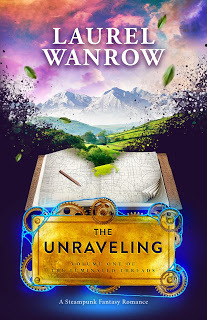
It’s available on Amazon in ebook and print if you’d like to hold that gorgeous cover in your hands. Laurel can be found on Pinterest, Goodreads, Facebook, @laurelwanrow and blogging at www.laurelwanrow.com. To be notified of new releases sign up for Laurel's Newsletter.
Steampunk Lessons from a Family History on Sawmill Operation ~ Part OneBy Laurel Wanrow

While writing The Unraveling, I was asked why I chose to locate my steampunk story in the countryside instead of London or another city, the gritty setting of most steampunks. I thought on this, and finally came to the conclusion it’s because I’d never been to London.
Now you have to understand, I’ve never lived on a farm either. But my dad did, and I’d been to plenty of farms. It’s a case of write what you know…almost. Machinery and steam engines were new territory for me, but here I had family help again. My grandfather—my dad’s father—owned and ran steam engines. Through stories my dad and his sister told I could more easily imagine life on a farm working with those big engines than any adventure in London’s back alleys.
Let me stop here and give fair notice that this article is an oral history, not a research document. This two part series of sawmill stories is a recollection of the times and how I used family tales to enhance my novel.
My grandfather, Herbert F. Wanrow, was a first generation American born in 1889 to a farming family in eastern Nebraska. But Herb didn’t seem to take to that life. Typical of most young men, he liked fancy cars…but needed an income to get them. By the time Herb reached his twenties in the 1910s, he was selling farm machinery. Companies such as Gleaner, Oliver, Avery, Case and Meikle shipped the parts in crates by rail to their nearest town, Humboldt, and Herb hauled them home with a horse and wagon and put them together.

Selling farm machinery was seasonal work, so pretty quickly Herb put his money into purchasing a sawmill to keep work going into the fall and winter.

Pouring over our photos, I got a sense of scale for an operation that these days most of us only see the results of in Home Depot. My grandfather’s sawmill consisted of the large upright blade and its mechanical parts, all of which were mounted in a substantial wheeled platform. Under the platform is a pit, dug to accommodate the sawdust. To move a sizable log—such as the one Herb is leaning against—past the blade with the precision to produce lumber required a wheeled carriage set on rails. This log (once cut, the tree trunk was always referred to as a log) has passed through the blade three times already to ‘square it up’, or remove the bark. After the final bark slab is removed, it’ll be called a cant.
For all that, the sawmill is only half the equipment needed; like many machines of the day, it wasn’t self-powered, but operated with a secondary source. By 1923, self-propelling machinery was being patented, but that doesn’t mean everyone could or did use it. During this time, in this part of Nebraska, horses or mules still powered the farm implements. But a sawmill required more power, so Herb also bought a steam engine. Its power is transmitted to the sawmill with a belt that runs around the wheel-like pulley to the far right.

Herb set up his steam engine with a windbreak of slabs some distance from the sawmill and ran the long belt between the two. Feeding wood—usually the endless supply of slabs—into the firebox at the back was the work of one full-time helper, a fireman. Another helper filled the water tanks on the back and front of the engine from a water tank on a wheeled carriage…and kept that water tank refilled from the closest source.
For one entrepreneur, Herb (in the felt hat) ran quite an operation. Beyond his fireman, the hands helping were usually the customer he was cutting wood for, and his boys or hired hands. They rolled the log onto the carriage, and then turned it with cant hooks. Using the upright ‘dogs’ to hold the log in place on the rolling carriage, Herb moved log after log through the blade to produce cants. From them, he cut the rough lumber to fill his customers’ orders.
 Only Herb did the sawing, riding in a seat along the cant. It was an art to size up and turn the cant to get the most efficient board feet out of it. Depending on what board dimensions the customer desired—thickness and length—Herb either advanced the cant with a notched cog for the next cut, or directed helpers to turn it. Helpers then carried off each board and stacked them so the weight of the pile would keep them from twisting. (My dad noted that in this photo, the stacks don’t look very good—but those fell to the customer to take care of.)
Only Herb did the sawing, riding in a seat along the cant. It was an art to size up and turn the cant to get the most efficient board feet out of it. Depending on what board dimensions the customer desired—thickness and length—Herb either advanced the cant with a notched cog for the next cut, or directed helpers to turn it. Helpers then carried off each board and stacked them so the weight of the pile would keep them from twisting. (My dad noted that in this photo, the stacks don’t look very good—but those fell to the customer to take care of.)Herb Wanrow owned the only steam engine and sawmill in the area. Word of his skill as a sawmill operator spread and those stacks of lumber earned him a winter income. Next week I’ll share how my grandfather took his business on the road.
~ ~ ~
Laurel Wanrow has dabbled in genealogy since high school, recording family history tales from both sides of her family, and her husband’s. She’s lucky enough to be caretaker for the Wanrow family cabin in the Rocky Mountains, built by her father and grandparents, though the lumber did not come from Herb’s sawmill.

The Unraveling, Volume One of The Luminated Threads is Laurel’s debut novel, a Steampunk Fantasy Romance is set in Victorian England in a rural valley of shapeshifters and magic.

It’s available on Amazon in ebook and print if you’d like to hold that gorgeous cover in your hands. Laurel can be found on Pinterest, Goodreads, Facebook, @laurelwanrow and blogging at www.laurelwanrow.com. To be notified of new releases sign up for Laurel's Newsletter.
Published on July 20, 2015 21:00
Video of the Week
Check out this video of the week: A different take on the Declaration!What do you think?
Published on July 20, 2015 11:33
July 16, 2015
Words in History
Then and Now: Word Definitions
enormitythen- horrific or monstrousnow- to great or extreme scaleperusethen- to use thoroughlynow- examine carefullyfulsomethen- rich or abundantnow- flattering or complimentarycomputerthen- someone who did a lot of calculationsnow- an electronic device for storing and processing data

careenthen- to tip or leannow- move swiftly
Erotic Word of The Week
arousedhot in the biscuitchuckedhorn madtumbling ripehaving a itch in the belly
enormitythen- horrific or monstrousnow- to great or extreme scaleperusethen- to use thoroughlynow- examine carefullyfulsomethen- rich or abundantnow- flattering or complimentarycomputerthen- someone who did a lot of calculationsnow- an electronic device for storing and processing data

careenthen- to tip or leannow- move swiftly
Erotic Word of The Week
arousedhot in the biscuitchuckedhorn madtumbling ripehaving a itch in the belly
Published on July 16, 2015 21:00
July 13th thru July 19th
What Happened This Week in History?
July 13, 1837- Queen Victoria is first monarch to live in present Buckingham Palace
July 14, 1987- "U Got The Look" by Prince was released
July 15, 1922- First duck-billed platypus exhibited in US for public, at New York zoo

July 16, 1439- Kissing is banned in England (to stop germs from spreading)
July 17, 1775- First military hospital approved
July 18, 1994- Crayola announces introduction of scented crayons
July 19, 1927- TY Cobb gets his 4,000th hit
July 13, 1837- Queen Victoria is first monarch to live in present Buckingham Palace
July 14, 1987- "U Got The Look" by Prince was released
July 15, 1922- First duck-billed platypus exhibited in US for public, at New York zoo

July 16, 1439- Kissing is banned in England (to stop germs from spreading)
July 17, 1775- First military hospital approved
July 18, 1994- Crayola announces introduction of scented crayons
July 19, 1927- TY Cobb gets his 4,000th hit
Published on July 16, 2015 10:37
July 13, 2015
KICK BUTT MEDIEVAL HEROINES by Vijaya Schartz
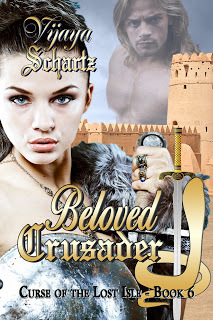 Welcome to History Undressed, guest author, Vijaya Schartz! She's with us today talking about one of my favorite topics--heroines who kick butt!
Welcome to History Undressed, guest author, Vijaya Schartz! She's with us today talking about one of my favorite topics--heroines who kick butt!KICK BUTT MEDIEVAL HEROINES by Vijaya Schartz
It’s not a secret, I love writing strong women, and I do not make exceptions for historical series. Strong heroines are a must in a society, especially one where women are not recognized as having a soul. Reviewers call THE CURSE OF THE LOST ISLE series “edgy medieval.” Yep, lots of edges there, Magic swords, daggers, arrows, lances... you get the picture.
Contrary to common belief, there were many strong women in the Middle Ages, despite the fact that they were considered inferior by the Church… and by men in general. A few of these queens and princesses are remembered to this day. Eleanor of Aquitaine comes to mind, and she was, according to legend and sparse records, descended from the Immortal Celtic Ladies featured in the Curse of the Lost Isle series. So was Richard the Lionheart.
And I’m not just talking about knights wielding swords, but ladies as well. While respecting history is important, it is just as important for the reader to identify with the characters of the time. So my medieval heroines are particularly strong-willed, resilient, and knowledgeable. Since they are immortal, after a few centuries they are also wise beyond their youthful appearance.
But these novel plots are far from random. I did intensive research over the past fifteen years, since the first idea for this series sparked in my mind. It was on the plane trip back from a French vacation. Born and raised in France, I still have family there. More trips to Europe ensued to research the archives of many locales mentioning legends involving the cursed Ladies of the Lost Isle. There will be several books following the four already published:
Beloved Crusader, Book 6 in the Curse of the Lost Isle series, is a standalone, as it is the only book featuring this particular sister Fae. It is set at a dangerous time for Pagans, as Christianity embarked on the first Crusade. Like her mother and her sisters, this magic heroine is a fighter. She fights for what is right, regardless of race or religion. She is brave enough to change herself to change the world.
Leave a comment for your chance to win an ebook copy of BELOVED CRUSADER!
About the Book:
Publication Date: April 14, 2015Books We Love Ltd.
Formats: eBook, Paperback
ISBN-13: 978-1771454193Series: Curse of the Lost Isle Series, Book Six
Genre: Historical Romance
1096 AD – To redeem a Pagan curse, Palatina the Fae braves the Christian world to embark on an expedition to free the Holy Sepulcher in Jerusalem from the Turks. Pierre de Belfort, Christian Knight of Lorraine, swore never to let a woman rule his life, and doesn’t believe in love. Thrown together into the turmoil of the First Crusade, on a sacred journey to a land of fables, they must learn to trust each other. For in this war, the true enemy is not human… and discovery could mean burning at the stake.
Praise for Beloved Crusader
“Ms. Schartz’s writing is spot on – it’s tight and flows well, there are no superfluous passages. It’s a pleasure to read excellent writing. Her descriptions are perfect to the mood and moment, with exact word choices. Plotting and characterization were excellent as well and kept me reading. Thank you for the wonderful escape!” 5-stars on Amazon
Ind'Tale Magazine says: "... a vivid look at what life could have been for Pagans and Christians alike. Palatina and Pierre are so lifelike, one could expect them to step out of the page, chain mail jingling and swords flashing." 5 stars (exceptional - crowned heart for excellence) Ind'Tale Magazine July/August 2015 issue.
Excerpt: BELOVED CRUSADER
Heart pounding, barely containing her excitement, she watched his tall figure stride with purpose into her lair. The warrior dwarfed the stone arch of the entrance with his imposing presence. The flames of the oil lamps wavered, casting shifting shadows on the rough stone shelves, strewn with worn, heavy volumes of ancient knowledge.
He walked slowly, deliberately, like a predator stalking prey. His wet tunic molded muscular shoulders. Golden hair dripped on his square face, tanned by the outdoors. A northerner.
A large silver cross glinted on his bare chest through the open fold of his linen tunic. A Celtic cross in a circle. A Pagan symbol... also used by Christians.
Palatina sensed a hint of Fae blood roiling through his veins, and she probed the mind of the handsome man to determine whether or not she could trust him. To her surprise, she could not read his thoughts. Strange. Perhaps, his spatter of Fae blood protected him from her probing.
"Who dares disturb the peace of this sacred cave?" Her voice strangled in her throat from lack of use. Her tone sounded strangely formal.
A small rodent scampered into the rocky recesses of the large cave.
The man took a deep breath, released it slowly, then faced her at three paces, feet slightly apart, hands behind his back. Still seated on her elevated flat rock, she gazed on an even keel into his deep blue eyes... eyes that could make any woman forget her duties.
He tilted his head, and the square lines of his smooth face relaxed into an amused smile that dimpled his cheeks and bared perfect white teeth. "I was expecting someone older."
Flustered, Palatina frowned. Was that meant to be a compliment or an insult? She wouldn’t let him manipulate her. She may not have lived at the imperial court, but she had seen enough of the world through her water basin to avoid such tactics. She steeled her voice. “I asked for your name and title.”
He bit back his smile and nodded. “Pierre de Belfort, knight of Lower Lorraine, my lady.”
She must make sure he was the one. As the guardian of her father’s treasure, she could only release it to the right man, for a worthy cause... or suffer the wrath of the Goddess. The Great One punished the slightest mistakes with ruthless curses. “State your family line.”
His brow arched. “I am the bastard son of a lowly concubine, my lady.”
She could tell this man had learned good manners and received a good education. His braies and tunic were fashioned of the best cloth, and his boots of the finest leather. Besides, he was a titled knight. “But your father is a powerful lord, is he not?”
He narrowed his gaze upon her. “Aye, he was. Before he passed, he bestowed upon me the modest holding of Belfort.”
Of Palatina’s two sisters, only Melusine had married and borne children... first in Luxembourg with Sigefroi, a son of Lorraine, then in Forez with Count Artaud. This knight had to be related to her somehow, and if he were, he might know of her dark family history. “Any ancient legends or Fae ancestry in your family line?”
The knight’s jaw tensed and his daunting blue eyes hardened to cold ice. His hand gripped the sword hilt. “Who dares challenge my good name?”
Palatina shuddered at his outburst. Why would he bristle at the mention of legends and Fae? She blinked away her surprise and cleared her throat but no words came.
“I gave you my name, my lady. Now I demand to know yours.” His rich baritone voice echoed throughout the cave, filling it with warmth.
“My name is Palatina, Princess of Alba, daughter of Pressine of Bretagne and King Elinas of Dumfries.” She didn’t mention immortal, or Fae, or cursed... not even Pagan.
Beloved Crusader Available atAmazon
About the Author
 Born in France, award-winning author Vijaya Schartz never conformed to anything and could never refuse a challenge. She likes action and exotic settings, in life and on the page. She traveled the world and claims to also travel through time, as she writes without boundaries about the future and the far away past. Her love of cats transpires in many of her books… and she has more than twenty-five novels published. Her stories collected numerous five star reviews and a few literary awards.
Born in France, award-winning author Vijaya Schartz never conformed to anything and could never refuse a challenge. She likes action and exotic settings, in life and on the page. She traveled the world and claims to also travel through time, as she writes without boundaries about the future and the far away past. Her love of cats transpires in many of her books… and she has more than twenty-five novels published. Her stories collected numerous five star reviews and a few literary awards.For more information on Vijaya Schartz and her books visit http://www.vijayaschartz.com. You can Facebook and Twitter.also find her on
Amazon B&N
Beloved Crusader Blog Tour Schedule
Monday, July 13
Spotlight at CelticLady’s Reviews
Spotlight & Giveaway at Teddy Rose Book Reviews Plus More Tuesday, July 14
Guest Post & Giveaway at History Undressed Wednesday, July 15
Spotlight & Giveaway at Unshelfish Thursday, July 16
Guest Post at A Literary Vacation
Spotlight at What Is That Book About Friday, July 17
Review at Book Nerd
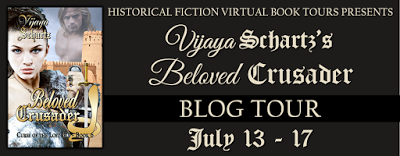
Published on July 13, 2015 21:00
Video of the Week
Want to learn about the Vikings? Check out this funny Horrible Histories video!
Published on July 13, 2015 14:22
July 9, 2015
Words in History
Then & Now Definition of Words Used in History
fantasticthen: something that was invented and didn't actually existnow: something wonderfulmeatthen: any kind of food itemnow: flesh of an animalpassengerthen: one who passes someonenow: someone traveling in a vehicleaddictthen: broke folk give as slavesnow: to surrender to something habituallyperfumethen: smokenow: pleasing scent
Erotic Word of the Week
Scrotumpursetwat hammerbozackwindy bagspunk worm
fantasticthen: something that was invented and didn't actually existnow: something wonderfulmeatthen: any kind of food itemnow: flesh of an animalpassengerthen: one who passes someonenow: someone traveling in a vehicleaddictthen: broke folk give as slavesnow: to surrender to something habituallyperfumethen: smokenow: pleasing scent

Erotic Word of the Week
Scrotumpursetwat hammerbozackwindy bagspunk worm
Published on July 09, 2015 21:00
July 8, 2015
July 6th thru July 12th
What Happened This Week in History?July 6, 1932- Postage rate for first class mail in the U.S. went up to 3-centsJuly 7, 2000- Amazon.com announced that almost 400,00 copies of "Harry Potter and the Goblet of Fire" were sold to make it the biggest selling book in e-tailing historyJuly 8, 1985- "Playboy" and "Penthouse" magazines were sold with nude pictures of MadonnaJuly 9, 1996- Prince released the album "Chaos and Disorder"July 10, 1910- Brookins became first to fly an airplane at an altitude of 1 mileJuly 11, 1914- Babe Ruth debuted with the Boston Red SoxJuly 12, 1543- England's King Henry VIII married his 6th and last wife Katherine Parr.
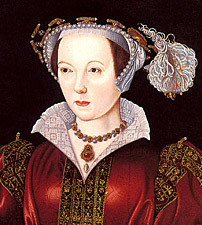

Published on July 08, 2015 21:00
July 7, 2015
Was Your Favorite Romance Hero Really Physically Fit? by Kathleen Bittner Roth
Welcome back to History Undressed, our regular 1st Tuesday of the month blogger, Kathleen Bittner Roth! Today she's talking about historical heroes and their fitness levels! Enjoy!
WAS YOUR FAVORITE ROMANCE HERO REALLY PHYSICALLY FIT?
by Kathleen Bittner Roth
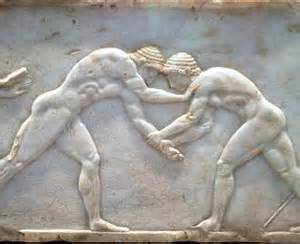
Back in the day of film stars like Humphrey Bogart, Jimmy Stewart and Clark Gable, there seemed to be little emphasis on physical fitness. Fast forward to 2015 and nearly every male actor in a lead role, romantic or otherwise, displays not only a well-toned, ripped body, he’s given the term “six pack” a whole new meaning. This shift in physical aesthetics got me wondering—what about the heroes in romance novels we authors write about and readers adore? Don’t we usually depict them with broad shoulders, slim hips and muscular thighs? Are we fantasizing about what never was, or are we closer to the truth than we realize? Curiosity piqued, I dove into a little research project and I learned a lot.

Present day film stars and athletes bear a lot of resemblance to the ancient Greek and Roman athletes whose very lives and livelihoods depended on their level of fitness both in mind and body. Staying fit today can translate into money. Big money. But believe it or not, it did back then, as well. What we consider immense earnings today don’t come close to those of the ancient athletes. Gaius Appuleius Diocles, a Roman chariot racer, became the wealthiest man in Rome in his time. Modern day figures would put this chariot jockey’s earning at over fifteen billion dollars! The dark ages descended upon man and everything tied to the physical/intellectual continuum faded away. Then came the Renaissance (1400-1600) which not only renewed an appreciation for human life, but renewed interest in fitness relating back to the Romans and Greeks (even Martin Luther, a religious leader, saw a connection between physical fitness and enhanced intellectual learning). This renewed interest in fitness brought about a development of physical education throughout Europe.
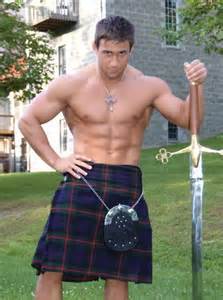
Walking was considered a fine form of exercise. The kilted Scot, an exceptional example of fitness, walked miles most days and could swing a heavy six-foot long claymore as if it were little more than a hammer (I know how heavy they were—I once gifted my late husband with a claymore for his birthday and when it arrived via UPS, I couldn’t lift the box to wrap it).

During the Georgian, Regency and Victorian eras, intellectually aware men kept their bodies fit through the art of fencing, a rigorous sport that toned virtually every muscle in the body. These men also boxed, used dumb bells to keep their upper bodies fit, and rode their fine horses, a favorite pastime that worked all their muscles and gave those thighs of theirs a good workout.
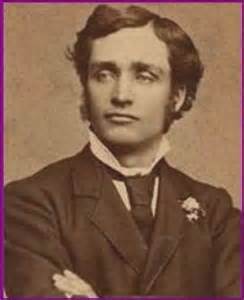
Then the industrial revolution evolved. Here’s where technology replaced labor-intensive jobs and urban life seemed more appealing than rural life. Consequently, people didn’t move around as much which led to a decline in physical fitness, particularly in the United States. But in time, that changed. One thing in my research regarding the physically fit hero is that I found a particularly interesting commonality between the fit mind-body concept and the power of the military. When WWI broke out, British forces underwent rigorous basic training, and when the United States entered the war theater of WWII, so many volunteers were not fit enough to stand the rigors of battle that the Army created a cross-fit basic training course (actually, much tougher than today’s basic training).

Out of basic training emerged advanced training which eventually produced special forces such as the Navy Seals—and you guessed it—physically fit, romantic heroes. It seems we’ve come full circle, back to the ancient Greeks and their idea of a fit body-mind continuum.So whether you read romance or write it, feel free to enjoy your broad-shouldered, slim-hipped, fabulously healthy hero. They really did and do exist.
Kathleen Bittner Roth thrives on creating passionate stories featuring characters who are forced to draw on their strength of spirit to overcome adversity and find unending love. Her own fairy tale wedding in a Scottish castle led her to her current residence in Budapest, Hungary, considered one of Europe’s most romantic cities. However, she still keeps one boot firmly in Texas and the other in her home state of Minnesota. A member of Romance Writers of America®, she was a finalist in the prestigious Golden Heart® contest. Find Kathleen on Facebook, Goodreads, Twitter, Pinterest and www.kathleenbittnerroth.com.
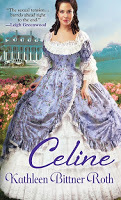
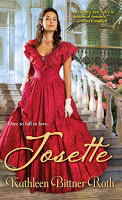

Check out Kathleen's list of books on Amazon!
Published on July 07, 2015 06:43
July 5, 2015
Video of the Week- Mime through Time by Sketchshe
Check out this week's video! Cute take on Music through history. Enjoy!
Published on July 05, 2015 21:00



